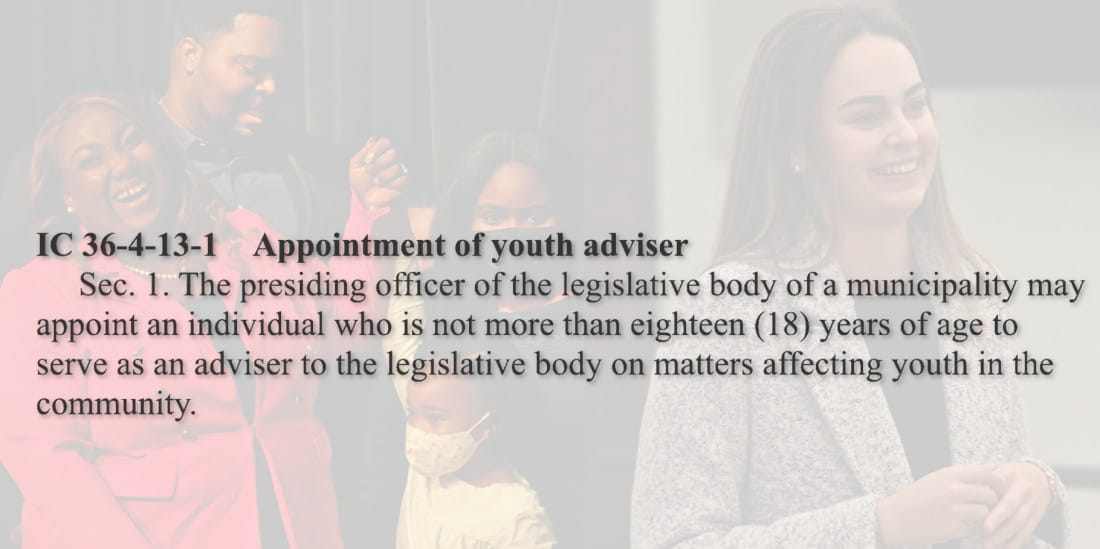Opinion: Bloomington city council should appoint a youth advisor, if it wants to keep pace with the GOP


A week before Christmas, both major political parties made local news with their caucuses.
Republicans elected 18-year-old Taylor Bryant as Monroe County Republican Party chair. Bryant became the youngest county chair ever for Monroe County and probably the state of Indiana.
At their caucus, Democrats chose Jennifer Crossley as a county councilor to replace Eric Spoonmore, who resigned. That made Crossley the first Black woman to serve on the county’s fiscal body.
Crossley’s age was not mentioned in any story that I saw reported by local news outlets. And why would it be? Even if Crossley is more than twice Bryant’s age (only by a smidgen), that’s true of most, if not all, elected officials in Monroe County.
Still, Crossley fits into a story about the age of local elected Democrats.
At 38 years old, Crossley is now the youngest person currently serving on the county council—although not the youngest ever.
Peter Iversen, who’s now next oldest, is 39. By swapping the 40-year-old Spoonmore for Crossley, the county council Democrats—six of seven councilors—dropped their average age a tiny bit, from 50.78 to 50.53 years.
If that sounds old, their half-century average is relatively young compared to Bloomington’s city council Democrats—which is all nine of them.
City council Democrats have an average age of 55.84 years, which makes them a half-decade older than county council Democrats.
If incumbents make up the whole field for Democrats in Bloomington’s 2023 municipal elections, I think they could face more resistance at the polls than they’ve typically seen in the last couple of cycles.
That resistance could come from younger voters on the Indiana University campus. They will have been mobilized by a GOP party chair (Bryant) and a political director (Makenzie Binford)—who are both IU students—to work and vote for city council candidates who don’t have a ‘D’ next to their names.
Depending on how the new city council districts get redrawn in 2022, student candidates could have an added advantage compared to now. If districts are drawn so that the campus is intact, mostly as a part of a single district, that could almost guarantee only college students as eligible candidates in that campus district.
There’s at least one plausible map like that, which balances the populations appropriately, given the 2020 census count.
Participation in municipal elections by university students is notoriously low. So whichever party has better on-campus organization would likely prevail, if both parties fielded a student candidate.
The GOP’s ‘boots on the campus ground’—which include not just the chair and the political director, but also the party’s grassroots campaign coordinators and social media director—give the party a campus presence that could have an impact.
In any case, I think Bloomington city council Democrats have at least a potential political vulnerability in 2023 among the younger demographic.
Monroe County Democrats will soon need to select a new chair, to replace Crossley who resigned when she was chosen as the replacement for Spoonmore on the county council. I think it’s unlikely that they’ll match the GOP for youth by picking an IU student to lead the party.
But city council Democrats might shore up whatever weak spot they have by appointing a youth advisor.
The potential vulnerability faced by city council Democrats is probably small. In the 2020 presidential race, the Monroe County breakdown was about 63 percent for Democrat Joe Biden, compared to 35 percent for Republican Donald Trump. The balance inside Bloomington was even starker.
But partisan politics are just one reason it would make sense for a city council youth advisor to be appointed sometime in 2022.
Another reason: Direct input from the youth in the community to the city’s legislative and fiscal body would add value to our local governance.
It was in 2008 when the state legislature enacted a law that explicitly allows a city council president to appoint a youth advisor. [IC 36-4-13-1]
Appointment of youth adviser
Sec. 1. The presiding officer of the legislative body of a municipality may appoint an individual who is not more than eighteen (18) years of age to serve as an adviser to the legislative body on matters affecting youth in the community.
In a second-class city like Bloomington, the presiding officer of the city council is the president. For third-class cities, it’s the mayor.
The statute leaves vague how the youth advisor is chosen or what their specific role would be. One thing is certain—that the youth advisor is not a member of the city council.
West Lafayette’s city council considered this year how a youth advisor would be appointed and what role the advisor would have. The approach taken by West Lafayette was to pass a resolution that provides a framework.
Among other issues addressed by the resolution is the requirement that the youth advisor be a high school junior or senior, and complete an application process. The West Lafayette city council youth advisor serves a term from August to May.
As the minutes from the West Lafayette city council’s Sept. 7 meeting indicate, while the resolution provides a framework, it’s the president of the council who makes the appointment.
The current president of Bloomington’s city council is at-large councilmember Jim Sims.
But the council chooses a president to start every calendar year. That choice will be made at the council’s Jan. 5 meeting.
It’s not a common pattern for someone to serve two years in a row as president. But that’s happened as recently as 2013 and 2014 when Darryl Neher served both years as president. Chris Gaal served as city council president two years in a row in 2002 and 2003.
The appointment of a youth advisor sometime in the first half of 2022—in time to start serving a term that starts in August—should be an easy political and public policy win for Bloomington’s city council.




Comments ()